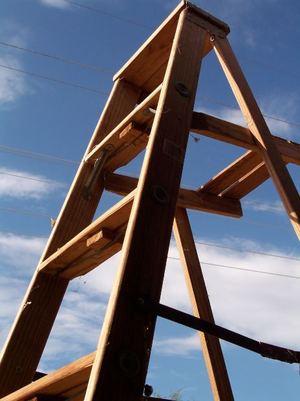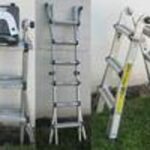As is the case with any project, having the right tools can make all the difference. Before you begin your next home improvement task, find out which ladder will work best for your needs. Material type, extension height, and weight capacity, can all play an important role in choosing the best ladder for your home. To ensure your safety, learn which types of ladders are available and how they can best benefit you.
Aluminum, wood, or fiberglass?
Ladders are typically made of either aluminum, wood, or fiberglass. Each one has its benefits and unique purpose.
Aluminum – While aluminum ladders are extremely durable and can be used indoors and out, they cannot be used for jobs that require electrical use. They are weatherproof, can withstand a great deal of weight, but can buckle after prolonged exposure to the heat.
Wood – Wood ladders were at one time the only type of ladder used by contractors, but once they were discovered to rot over time, they were replaced by other materials. Now, wood ladders are typically used for indoor construction, or for access to attic or loft rooms. The main benefit to using a wood ladder for home improvement asks is that they won’t conduct electricity, making them a safe choice for electrical work.
Fiberglass – Fiberglass ladders are, arguably, the best types of ladders on the market. They’re extremely, lightweight, and can be used for any purpose. They don’t conduct electricity, can be used indoors or out, and are difficult to damage.
Once you’ve decided on the best material for your ladder, there are many different types of ladders to consider. Some are better for reaching than others, some are easier to store, and others are designed to be used along stairways and hard to reach places.
Stepladder – Every home should be equipped with a stepladder. They’re great for reaching objects overhead, and implement steps instead of ladder rungs for extra stability. Many models are available that fold so they can be kept out of the way when not in use.
Telescoping Ladder – These types of ladders are unique in that each section collapses down into the one below it, therefore, they are great choice for someone who is short on storage space. They can be extended out in 1′ sections, so you can choose exactly how long you need the ladder to be. In other words, even though the ladder may extend to a maximum of 12′, you can choose to unfold it out to only 6′ in length. When you’re done, fold it back into position and store it out of the way.
Platform Ladder – At the top of a platform ladder, there is a small platform that can hold tools and supplies and keep them steady. This is one of the most popular types of ladders for homeowners that enjoy DIY projects because they make painting projects, electrical work, and basic home construction, more convenient. Everything you need can be kept right at your fingertips while you work.
Extension Ladder – An extension ladder is a tool that will be used exclusively for outdoor work. Typically, it is used to reach a second or third floor of the home, to clean out the gutters, or access the rooftop. These types of ladders feature sliding sections that extend to the desired height, reaching up to 60′.
Articulated Ladder – You may have seen these types of ladders advertised on infomercials and been impressed with their ability to bend and hold their position at odd angles. If you’re looking for a ladder that will work for virtually any job, you can’t go wrong with an articulated ladder. This one unit can be used as a step ladder, straight ladder, or bent to create an in-home scaffolding support. The joints of the unit bend and lock into place so that they can be positioned safely on stairways. The downfall to the uniqueness of these ladders is that they cost more than the others listed.
Before choosing a ladder, be sure the weight capacity will work for your needs. Consider not only the weight of the user, but also the weight of supplies and tools needed to complete your project.
More from Jennifer Wagner:
Must-Have Tools for Every Toolbox
12 Weekend Home Improvement Projects
DIY Kitchen Demolition Basics
Source:
Personal knowledge
Jennifer Wagner: Yahoo! Contributor Network






